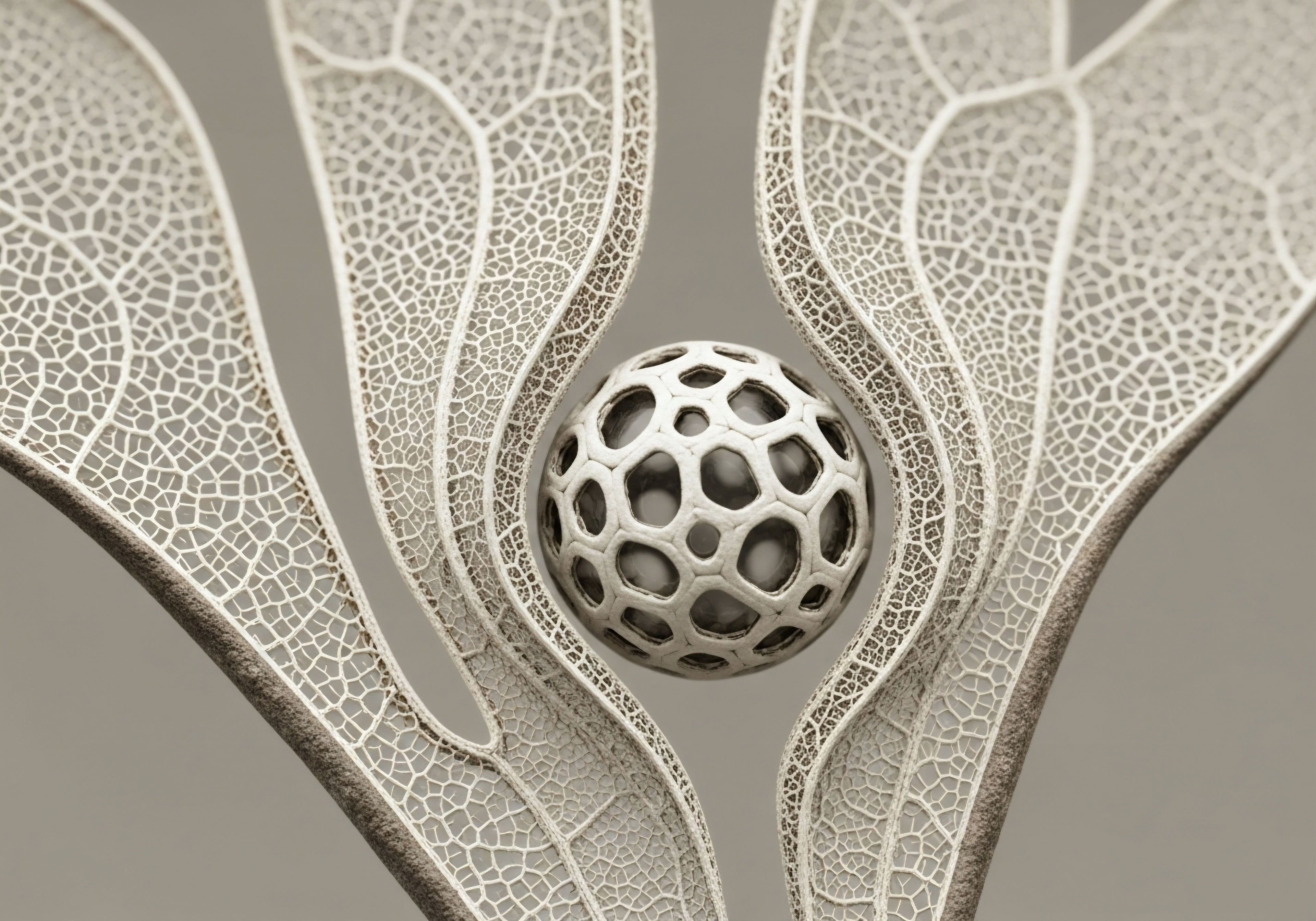

Fundamentals
When you observe changes in your hair ∞ perhaps a thinning crown, a receding hairline, or a noticeable decrease in density ∞ it can feel like a profound shift, touching not just your appearance but your sense of vitality. This experience often brings with it a cascade of questions, and a quiet concern about what these visible alterations might signify within your body.
Many individuals experiencing such changes also report a general sense of diminished energy, altered sleep patterns, or shifts in mood, suggesting that hair health is rarely an isolated concern. These symptoms are not merely cosmetic; they frequently serve as subtle indicators, whispers from your internal biological systems, signaling a need for closer attention to your overall physiological balance.
Understanding the intricate interplay of your body’s internal messengers is the initial step toward reclaiming a sense of well-being. Your endocrine system, a complex network of glands and hormones, orchestrates nearly every bodily function, from metabolism and mood to growth and reproduction.
Hormones, acting as chemical signals, travel through your bloodstream, influencing cells and tissues far from their point of origin. When these signals become disrupted, even subtly, the effects can ripple throughout your entire system, impacting areas you might not immediately connect, such as the health and growth cycle of your hair follicles.
Hair follicles are remarkably active biological structures, undergoing a continuous cycle of growth, rest, and shedding. This cycle is exquisitely sensitive to hormonal fluctuations. Androgens, a class of hormones including testosterone and dihydrotestosterone (DHT), play a significant, yet complex, role in hair health.
While often associated with male characteristics, these hormones are present in both men and women and are critical for various bodily functions. In certain individuals, an imbalance or heightened sensitivity to these hormones within the scalp can lead to miniaturization of hair follicles, resulting in thinner, shorter hairs, and eventually, a reduction in overall hair density.
Hair changes often reflect deeper systemic shifts, prompting a closer examination of the body’s internal balance.
Beyond the direct influence of androgens, other hormonal systems contribute to the follicular environment. Thyroid hormones, for instance, are essential for metabolic regulation and cellular activity, including the rapid cell division required for hair growth. Imbalances in thyroid function can lead to diffuse hair shedding.
Similarly, the delicate balance of estrogen and progesterone in women profoundly impacts hair health, with shifts during perimenopause and post-menopause frequently correlating with changes in hair texture and density. The body’s stress response system, involving cortisol, also exerts an influence, potentially disrupting the hair growth cycle.

The Body’s Messaging System
Consider your body as a highly sophisticated communication network. Hormones are the primary messages, traveling along specific pathways to deliver instructions. When these messages are clear and delivered effectively, all systems operate optimally. When there is interference or a misdelivery of these messages, certain functions can falter. Hair thinning, in this context, can be seen as a visible manifestation of these internal communication challenges. It is a signal that warrants a deeper investigation into the underlying biochemical landscape.
Understanding the foundational principles of hormonal regulation is paramount. The hypothalamic-pituitary-gonadal (HPG) axis, for example, is a central regulatory pathway governing reproductive and stress responses, directly influencing the production of sex hormones. A similar axis, the hypothalamic-pituitary-adrenal (HPA) axis, manages the body’s response to stress.
These axes are not isolated; they are interconnected, forming a complex web of feedback loops that maintain physiological equilibrium. Disruptions in one area can cascade, affecting others, including the health of your hair follicles.

Peptides as Biological Signals
Within this intricate biological communication system, peptides represent another class of powerful signaling molecules. These are short chains of amino acids, acting as highly specific messengers that can direct cellular activity, modulate immune responses, and influence tissue repair. Unlike larger proteins or broad-acting hormones, peptides often target specific receptors, eliciting precise biological responses.
In the context of hair health, certain peptides have garnered attention for their potential to stimulate hair follicle activity, promote cellular regeneration, and modulate inflammatory pathways within the scalp.
The concept of integrating peptide therapies with traditional hormone optimization protocols stems from this understanding of interconnected biological systems. Hormonal balance provides the foundational environment for overall health, including robust hair growth. Peptides, with their targeted signaling capabilities, can then act as specialized agents, working synergistically with optimized hormone levels to address specific cellular processes related to hair follicle vitality.
This combined approach aims to create a more comprehensive strategy, addressing both systemic hormonal equilibrium and localized cellular mechanisms crucial for hair regrowth.


Intermediate
Once a foundational understanding of hormonal influence on hair health is established, the next step involves exploring specific clinical protocols designed to restore balance and promote follicular regeneration. Traditional hormone optimization protocols, particularly those involving testosterone and progesterone, form the bedrock of systemic recalibration. These therapies aim to correct deficiencies or imbalances that can contribute to a range of symptoms, including hair thinning.

Testosterone Optimization for Hair Health
For men experiencing symptoms of low testosterone, often termed andropause, testosterone replacement therapy (TRT) can be a transformative intervention. A standard protocol often involves weekly intramuscular injections of Testosterone Cypionate, typically at a concentration of 200mg/ml. This exogenous testosterone helps restore circulating levels to a physiological range, addressing symptoms such as diminished energy, reduced muscle mass, and changes in hair density.
However, the relationship between testosterone and hair is nuanced. While low testosterone can contribute to overall hair thinning, its conversion to dihydrotestosterone (DHT) can, in genetically predisposed individuals, accelerate androgenic alopecia.
To mitigate potential side effects associated with elevated estrogen levels resulting from testosterone aromatization, an aromatase inhibitor like Anastrozole is often prescribed, typically as a 2x/week oral tablet. This helps maintain a healthy testosterone-to-estrogen ratio. Additionally, to preserve endogenous testosterone production and fertility, Gonadorelin, a gonadotropin-releasing hormone (GnRH) analog, may be administered via subcutaneous injections twice weekly.
Gonadorelin stimulates the pituitary gland to release luteinizing hormone (LH) and follicle-stimulating hormone (FSH), which are essential for testicular function. In some cases, Enclomiphene, a selective estrogen receptor modulator, may be included to further support LH and FSH levels, promoting natural testosterone synthesis.
Testosterone optimization in men balances systemic health with careful management of hair-related hormonal pathways.
For women, testosterone optimization protocols are tailored to address symptoms such as irregular cycles, mood fluctuations, hot flashes, and reduced libido, which can also coincide with hair changes. Subcutaneous injections of Testosterone Cypionate, typically at a much lower dose of 10 ∞ 20 units (0.1 ∞ 0.2ml) weekly, are common.
This micro-dosing aims to restore physiological testosterone levels without inducing virilizing effects. Progesterone is often prescribed concurrently, particularly for peri-menopausal and post-menopausal women, to balance estrogen levels and support uterine health. Pellet therapy, involving long-acting testosterone pellets inserted subcutaneously, offers another delivery method, with Anastrozole considered when appropriate to manage estrogen conversion.

Peptide Therapies for Hair Regrowth
Peptides offer a targeted approach to hair regrowth, working at the cellular level to influence the hair follicle cycle and scalp environment. These agents can be integrated with hormone optimization to provide a comprehensive strategy.

Growth Hormone Secretagogues
Certain peptides are known as growth hormone secretagogues, meaning they stimulate the body’s natural production of growth hormone (GH). GH plays a vital role in cellular repair, tissue regeneration, and metabolic function, all of which indirectly support hair health.
- Sermorelin ∞ This peptide is a synthetic analog of growth hormone-releasing hormone (GHRH). It stimulates the pituitary gland to release GH in a pulsatile, physiological manner. Improved GH levels can enhance cellular turnover and nutrient delivery to hair follicles.
- Ipamorelin / CJC-1295 ∞ This combination is a potent GH secretagogue. Ipamorelin is a selective GH secretagogue, while CJC-1295 (with DAC) extends its half-life, leading to sustained GH release. The combined effect can support overall tissue health, including the scalp.
- Tesamorelin ∞ A GHRH analog, Tesamorelin is primarily known for its role in reducing visceral fat, but its systemic effects on GH can contribute to improved metabolic health, which indirectly benefits hair vitality.
- Hexarelin ∞ Another GH secretagogue, Hexarelin also has a mild effect on ghrelin receptors, potentially influencing appetite and metabolism, alongside its GH-releasing properties.
- MK-677 (Ibutamoren) ∞ While not a peptide, MK-677 is a non-peptide GH secretagogue that orally stimulates GH release. It can support muscle gain, fat loss, and sleep improvement, all of which contribute to a healthier internal environment conducive to hair growth.

Targeted Peptides for Hair and Tissue Repair
Beyond GH secretagogues, other peptides directly influence tissue repair and cellular processes relevant to hair.
- Pentadeca Arginate (PDA) ∞ This peptide is recognized for its role in tissue repair, healing, and modulating inflammatory responses. Chronic inflammation in the scalp can impede hair growth, and PDA’s anti-inflammatory properties could create a more favorable environment for follicles. Its regenerative capabilities also support the cellular structures within the scalp.
- PT-141 (Bremelanotide) ∞ Primarily known for its effects on sexual health, PT-141 acts on melanocortin receptors. While not directly a hair growth peptide, systemic improvements in well-being and stress reduction can indirectly support hair health.

Integrating Protocols
The integration of peptide therapies with traditional hormone optimization protocols involves a strategic layering of interventions. Hormone optimization establishes a robust systemic foundation, ensuring that the body’s primary messengers are balanced. This creates an optimal internal environment for cellular function. Peptides then act as precision tools, targeting specific pathways that promote hair follicle health and regeneration.
Consider the analogy of a garden. Hormone optimization is like ensuring the soil has the correct pH and nutrient balance ∞ a fundamental requirement for any plant to thrive. Peptide therapies are then like specialized fertilizers or growth stimulants, applied directly to specific plants (hair follicles) to encourage their robust growth and resilience within that well-prepared soil.
A typical integrated approach might involve initiating a testosterone optimization protocol to address systemic hormonal deficiencies. Once stable hormone levels are achieved, a growth hormone secretagogue like Sermorelin or Ipamorelin/CJC-1295 could be introduced to enhance cellular repair and regeneration, benefiting the hair follicles. For localized scalp inflammation or specific tissue repair needs, PDA could be considered. This layered approach allows for a comprehensive attack on the multifactorial causes of hair thinning.
| Therapy Type | Primary Role | Mechanism for Hair Health | Examples |
|---|---|---|---|
| Hormone Optimization | Systemic balance, foundational health | Corrects underlying hormonal deficiencies, creates optimal physiological environment for cellular function, including hair follicles. | Testosterone Cypionate, Progesterone, Anastrozole |
| Peptide Therapy | Targeted cellular signaling, specific regeneration | Stimulates growth factors, modulates inflammation, enhances cellular repair, directly influences hair follicle cycle. | Sermorelin, Ipamorelin/CJC-1295, PDA |
The decision to integrate these protocols is always individualized, based on comprehensive laboratory assessments, clinical symptoms, and a thorough understanding of the patient’s overall health profile. The goal is to create a synergistic effect, where the combined therapies yield greater benefits than either approach alone, leading to improved hair density and overall vitality.


Academic
The integration of peptide therapies with traditional hormone optimization protocols for hair regrowth necessitates a deep understanding of the molecular and cellular mechanisms governing hair follicle biology and endocrine system interactions. Hair follicle cycling is a highly regulated process, involving complex signaling pathways, stem cell activity, and a delicate balance of growth factors and inhibitory signals. Disruptions at any point in this intricate cascade can lead to various forms of alopecia.

Endocrine System Influence on Hair Follicle Dynamics
The hair follicle is a mini-organ, highly responsive to systemic hormonal fluctuations. Androgens, particularly dihydrotestosterone (DHT), play a central role in androgenetic alopecia (AGA), the most common form of hair loss. In genetically susceptible individuals, 5-alpha reductase enzymes convert testosterone into DHT within the hair follicle.
DHT then binds to androgen receptors in the dermal papilla cells, leading to a cascade of events that miniaturize the follicle, shortening the anagen (growth) phase and prolonging the telogen (resting) phase. This results in progressively finer, shorter, and less pigmented hairs.
Estrogens and progesterone, while less directly implicated in AGA, are critical for maintaining the anagen phase in women. Declining levels during perimenopause and menopause can shift the hair cycle, leading to diffuse thinning. Thyroid hormones (T3 and T4) are essential for metabolic activity in all cells, including the highly proliferative cells of the hair matrix.
Hypothyroidism can cause telogen effluvium, a condition characterized by widespread hair shedding. The interplay of these hormones underscores the necessity of systemic endocrine balance for optimal hair health.
Hair follicle health is intricately linked to the precise balance of systemic hormones and local growth factors.

Growth Hormone Axis and Follicular Regeneration
The growth hormone (GH) / insulin-like growth factor 1 (IGF-1) axis is a powerful regulator of cellular proliferation, differentiation, and tissue repair. GH, secreted by the anterior pituitary, stimulates the liver and other tissues to produce IGF-1, which mediates many of GH’s anabolic effects. Hair follicles possess receptors for both GH and IGF-1, suggesting a direct role in follicular dynamics. IGF-1 is known to promote the proliferation of dermal papilla cells and stimulate the anagen phase of hair growth.
Peptides like Sermorelin and the combination of Ipamorelin / CJC-1295 function as growth hormone secretagogues. Sermorelin, a GHRH analog, binds to GHRH receptors on somatotrophs in the anterior pituitary, leading to a pulsatile release of endogenous GH. Ipamorelin, a ghrelin mimetic, also stimulates GH release via ghrelin receptors, while CJC-1295 (with DAC) extends the half-life of GHRH, providing a more sustained GH elevation.
By augmenting endogenous GH and subsequent IGF-1 levels, these peptides can create a more favorable environment for hair follicle stem cell activation and proliferation, potentially extending the anagen phase and promoting robust hair shaft formation.
Clinical studies on GH secretagogues, while primarily focused on body composition and anti-aging, often report anecdotal improvements in hair quality and growth. The systemic metabolic improvements, including enhanced protein synthesis and cellular repair, contribute to the overall health of the integumentary system.

Targeted Peptides and Cellular Pathways
Beyond the GH axis, other peptides offer more direct, localized effects on hair follicles. Pentadeca Arginate (PDA), for instance, is a synthetic peptide derived from a naturally occurring protein involved in tissue repair. Its mechanism of action involves modulating inflammatory pathways and promoting cellular regeneration.
Chronic micro-inflammation in the scalp, often subclinical, can contribute to hair loss by damaging hair follicle stem cells and disrupting the follicular microenvironment. PDA’s anti-inflammatory properties could help mitigate this damage, creating a more conducive environment for hair growth. Its regenerative capabilities may also directly support the repair of damaged follicular structures.
The interaction between systemic hormones and localized peptide signaling is a critical aspect of integrated protocols. For example, optimizing testosterone levels in men with hypogonadism provides the necessary substrate for physiological function, but also introduces the potential for increased DHT conversion. Concurrently administering a GH secretagogue could enhance the regenerative capacity of follicles, while a peptide like PDA could address localized inflammatory responses, thereby offering a multi-pronged approach to hair preservation and regrowth.

Synergistic Mechanisms in Hair Regrowth
The synergy between hormone optimization and peptide therapy can be conceptualized through several interacting pathways:
- Systemic Homeostasis ∞ Hormone optimization restores the fundamental biochemical balance necessary for all cellular processes, including those in the hair follicle. This ensures that the cellular machinery has the correct ‘fuel’ and ‘instructions’ to operate efficiently.
- Growth Factor Modulation ∞ GH secretagogues increase systemic IGF-1, a potent growth factor for hair follicles. This complements the foundational hormonal support by directly stimulating cellular proliferation and extending the anagen phase.
- Inflammation Control ∞ Peptides like PDA can reduce localized scalp inflammation, which is a known contributor to hair loss. This creates a healthier microenvironment for existing follicles and supports the activity of stem cells.
- Cellular Repair and Regeneration ∞ Both optimized hormone levels and specific peptides contribute to enhanced cellular repair mechanisms, ensuring the integrity and function of the dermal papilla and hair matrix cells.
| Agent Type | Key Molecular Targets | Cellular Mechanisms | Hair Follicle Impact |
|---|---|---|---|
| Androgens (e.g. DHT) | Androgen Receptors, 5-alpha Reductase | Follicle miniaturization, shortened anagen phase | Androgenetic alopecia progression |
| Estrogens/Progesterone | Estrogen Receptors, Progesterone Receptors | Anagen phase maintenance, follicular health | Supports hair density, prevents diffuse thinning |
| GH Secretagogues | GHRH Receptors, Ghrelin Receptors | Increased GH/IGF-1 production, cellular proliferation, protein synthesis | Promotes anagen phase, enhances follicle vitality |
| Pentadeca Arginate | Inflammatory pathways, tissue repair factors | Anti-inflammatory effects, cellular regeneration | Reduces scalp inflammation, supports follicle repair |
The clinical application of these integrated protocols requires meticulous monitoring of hormone levels, growth factors, and inflammatory markers. Regular laboratory assessments, including comprehensive hormone panels, IGF-1 levels, and inflammatory markers, are essential to guide dosage adjustments and assess therapeutic efficacy.
The ultimate goal is to restore not just hair density, but also the underlying physiological resilience that supports long-term well-being. This sophisticated approach represents a frontier in personalized wellness, moving beyond symptomatic treatment to address the root biological drivers of vitality.

Can Genetic Predisposition Influence Treatment Outcomes?
Genetic factors play a substantial role in an individual’s response to both hormonal and peptide therapies for hair regrowth. For instance, variations in the androgen receptor gene or the 5-alpha reductase enzyme can influence susceptibility to androgenetic alopecia and the effectiveness of anti-androgen interventions.
Similarly, an individual’s genetic profile might affect their endogenous growth hormone secretion capacity or their receptor sensitivity to various peptides. Understanding these genetic predispositions through advanced genomic testing can help clinicians tailor protocols, predicting potential responsiveness and optimizing therapeutic strategies for a more precise and personalized outcome.

References
- Kligman, Albert M. “The human hair follicle ∞ a miniature organ.” Journal of Investigative Dermatology, vol. 101, no. 1, 1993, pp. 1-2.
- Messenger, Andrew G. and Andrew P. de Berker. “The biology of hair follicles.” British Medical Journal, vol. 326, no. 7398, 2003, pp. 1067-1069.
- Trueb, Ralph M. “Molecular mechanisms of androgenetic alopecia.” Experimental Gerontology, vol. 37, no. 8-9, 2002, pp. 981-990.
- Stough, Daniel, et al. “The role of growth factors in hair loss.” Journal of Drugs in Dermatology, vol. 11, no. 3, 2012, pp. 308-312.
- Giustina, Andrea, et al. “Growth hormone and IGF-I in hair biology.” Endocrine Reviews, vol. 22, no. 4, 2001, pp. 503-514.
- Kassab, Mohamed, et al. “The role of peptides in dermatology.” Journal of Cosmetic Dermatology, vol. 20, no. 1, 2021, pp. 12-20.
- Veldhuis, Johannes D. et al. “Physiological pulsatile growth hormone secretion in healthy men.” Journal of Clinical Endocrinology & Metabolism, vol. 72, no. 1, 1991, pp. 122-132.
- Mauras, Nelly, et al. “Growth hormone and testosterone in healthy men ∞ a randomized, placebo-controlled trial.” Journal of Clinical Endocrinology & Metabolism, vol. 91, no. 7, 2006, pp. 2634-2641.
- Schmidt, Michael A. Brain-Building Nutrition ∞ The Healing Power of Peptides, Amino Acids, and Neurotransmitters. North Atlantic Books, 2000.
- Hotta, Mitsuru, et al. “Growth hormone-releasing peptide-2 (GHRP-2) stimulates hair growth in mice.” Journal of Investigative Dermatology, vol. 119, no. 3, 2002, pp. 603-608.

Reflection
As you consider the intricate dance between your hormones and the vitality of your hair, perhaps a deeper appreciation for your body’s inherent wisdom begins to settle. The journey toward understanding your biological systems is not a destination, but a continuous process of learning and recalibration. Each symptom, each subtle shift, serves as a piece of information, guiding you toward a more complete picture of your unique physiological landscape.
This exploration of hormone optimization and peptide therapies for hair regrowth is a testament to the sophisticated approaches now available in personalized wellness. It is an invitation to move beyond generic solutions and to truly engage with the science of your own being. The knowledge shared here is a starting point, a framework for a conversation with a qualified practitioner who can help translate these complex principles into a protocol tailored precisely for you.
Your body possesses an extraordinary capacity for balance and regeneration. By providing it with the precise signals and support it requires, you are not merely addressing a symptom; you are actively participating in the restoration of your systemic health. This proactive stance, rooted in scientific understanding and a deep respect for your individual biology, is the pathway to reclaiming your full potential and experiencing a renewed sense of well-being.



